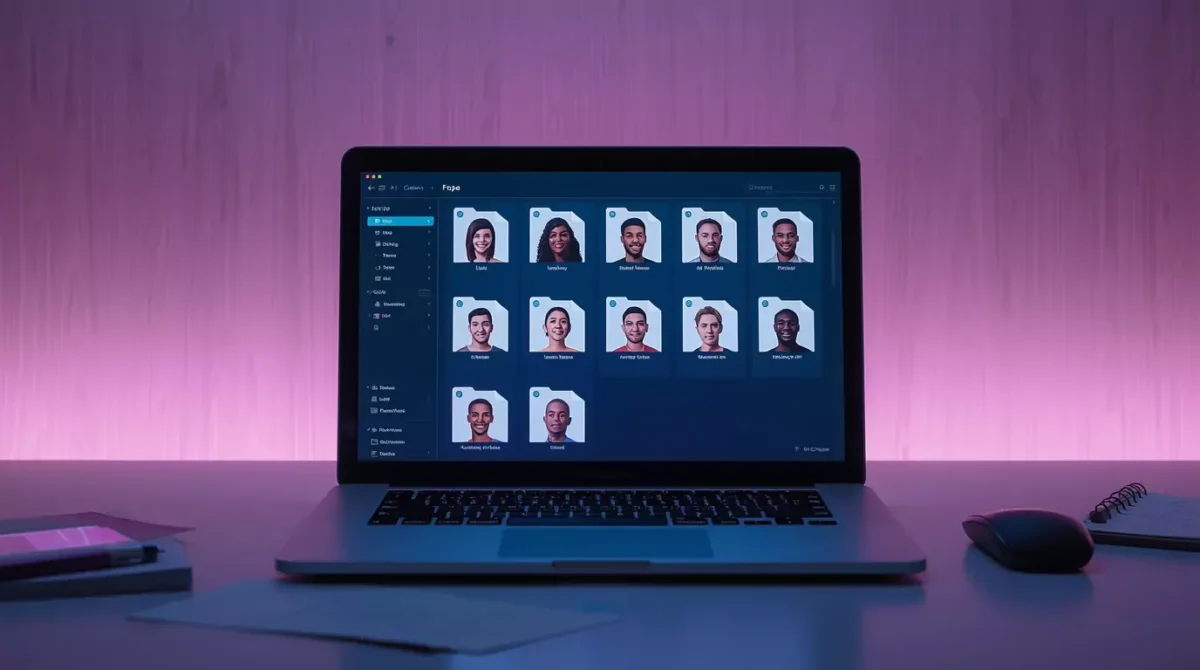You’ve got 10,000 photos scattered across your phone, laptop, and three different cloud services.
Finding that one picture of your kid’s birthday party from two years ago?
It’s like searching for a needle in a haystack.
But here’s the thing – AI face clustering technology is about to change your life.
And I’m not talking about some fancy tech you need a computer science degree to use.
I’m talking about tools that do the heavy lifting for you.
Jump to
ToggleWhy Most People Fail at Photo Organization
Here’s what happens to 99% of people:
They take photos. They promise themselves they’ll organize them “later.” Later never comes. They end up with digital chaos.
Sound familiar?
I used to have 47,000 photos on my phone.
No joke.
Finding anything was impossible.
Then I discovered AI face clustering and everything changed.
What Is AI Face Clustering Technology?
Think of it like having a super-smart assistant who can instantly recognize every person in your photos.
This technology scans your entire photo collection. It identifies faces. It groups all photos of the same person together. It does this automatically.
No manual tagging. No endless scrolling. No pulling your hair out.
The AI does what would take you weeks in just a few hours.
How AI Face Recognition Actually Works
Here’s the simple version:
The software looks at facial features like the distance between your eyes, nose shape, and jawline.
It creates a unique “fingerprint” for each face.
Then it matches that fingerprint across all your photos.
Pretty cool, right?
But here’s where it gets really good – modern AI doesn’t just match identical photos.
It recognizes the same person even when they’re wearing sunglasses, have different hairstyles, or have aged over the years.
Best Tools for Digital Photo Organization with Face Clustering
Google Photos
- Free up to 15GB
- Works on everything (phone, computer, tablet)
- Face grouping happens automatically
- Search by typing “Mom” or “Sarah”
I’ve been using this for three years.
Game changer.
Apple Photos
- Built into your iPhone/Mac
- Creates “People” albums automatically
- Syncs across all your Apple devices
- Privacy-focused (processing happens on your device)
Adobe Lightroom
- Professional-grade organization
- Face recognition plus keyword tagging
- Best for serious photographers
- Monthly subscription required
Mylio Photos
- Works offline
- Face recognition without cloud storage
- Good for privacy-conscious users
- One-time purchase option
Step-by-Step Guide to Organize Your Photos
Step 1: Pick Your Platform
Don’t overthink this.
If you use iPhone – go with Apple Photos. If you use Android – Google Photos is your friend. If you’re a photographer – consider Lightroom.
Step 2: Upload Everything
This is the hard part.
You need to gather photos from:
- Your phone
- Your computer
- Old hard drives
- Cloud services
- That USB drive in your junk drawer
I know it’s painful.
Do it anyway.
Step 3: Let the AI Work Its Magic
Once everything’s uploaded, the face clustering technology starts working.
Don’t interfere.
Let it run overnight.
Go make coffee.
Step 4: Review and Name Your Clusters
The AI will create groups of faces.
Some will be perfect. Others might need tweaking.
Name each person.
Be specific – “Uncle Bob” not just “Bob.”
Step 5: Create Smart Albums
Most platforms let you create albums that automatically update.
Examples:
- “Family Vacations” (photos with family members at vacation spots)
- “Kids 2023” (all photos of your children from this year)
- “Sarah’s First Year” (tracking your baby’s growth)
Pro Tips That Actually Work
Start with your most recent photos first.
Why torture yourself with photos from 2007 when you can’t even find last week’s pictures?
Use the search function religiously.
Type things like:
- “Beach 2023”
- “Christmas dinner”
- “Sarah birthday”
Don’t perfectionism yourself into paralysis.
80% organized is infinitely better than 0% organized.
Create yearly backup routines.
I export all my organized photos to an external drive every December.
Insurance against digital disasters.
Common Mistakes to Avoid
Mistake #1: Trying to organize everything at once
This is how people burn out.
Start with one year. Or one event. Build momentum.
Mistake #2: Not trusting the AI
The technology isn’t perfect, but it’s way better than you think.
Let it do most of the work. You just handle the exceptions.
Mistake #3: Creating too many categories
Keep it simple.
Family, friends, work, travel.
That’s probably enough for most people.
Mistake #4: Forgetting about duplicates
AI face clustering helps with organization, but you still need to deal with duplicate photos.
Most platforms have duplicate detection built-in.
Use it.
Privacy and Security Concerns
Let’s address the elephant in the room.
Yes, you’re giving these companies access to your photos.
Here’s how to think about it:
Cloud-based services (Google Photos):
- Convenient and powerful
- Your photos are on their servers
- They improve their AI using your data
On-device processing (Apple Photos):
- More private
- Processing happens on your device
- Slower but more secure
Offline solutions (Mylio):
- Complete privacy
- You control everything
- More setup required
Pick what matches your comfort level.
Advanced Organization Strategies
Create Event-Based Albums
Don’t just organize by person.
Organize by moments:
- “Sarah’s Wedding 2023”
- “Italy Trip September”
- “Kids Soccer Season”
Use Keywords and Tags
Beyond faces, tag photos with:
- Locations
- Events
- Activities
- Objects
This makes searching incredibly powerful.
Set Up Automatic Sharing
Create shared albums for:
- Family members
- Close friends
- Work projects
People get updates automatically when you add new photos.
Troubleshooting Common Issues
“The AI grouped different people together”
This happens.
Go into the person’s album. Remove the incorrect photos. The AI learns and gets better.
“It’s not recognizing some faces”
Poor lighting, angles, or image quality can cause this.
You can manually add photos to person albums.
“It’s taking forever to process”
Processing thousands of photos takes time.
Leave your device plugged in overnight.
Be patient.
The Real Benefits You’ll Actually Notice
After organizing 30,000+ photos with AI face clustering technology, here’s what changed for me:
I actually look at old photos now.
Finding specific memories takes seconds, not hours.
I share more photos with family because I can find them.
I stopped taking 47 versions of the same shot because I knew I could find the good ones later.
Family members love the automatically generated memory videos.
FAQ
How accurate is AI face recognition?
Modern AI is about 95-98% accurate under good conditions. It struggles with poor lighting, extreme angles, or very young children who change appearance quickly.
Can I use face clustering on old photos?
Absolutely. The AI works on any digital photo, regardless of when it was taken. Older, lower-quality photos might have more recognition errors.
Does face clustering work with group photos?
Yes, it can identify multiple faces in a single photo. This is actually where it shines – imagine finding every photo where you and your spouse appear together.
What about privacy with cloud services?
Cloud services process your photos on their servers. If privacy is a concern, look for solutions that process photos locally on your device.
How much storage do I need?
It depends on your photo collection size. Google Photos offers 15GB free, Apple iCloud starts at 5GB free. Most people need paid storage for large collections.
Can I organize photos across multiple devices?
Yes, cloud-based solutions sync across all your devices. Take a photo on your phone, and it appears organized on your computer automatically.
Making It Happen
Here’s the bottom line:
Your photos are memories.
Right now, those memories are buried in digital chaos.
AI face clustering technology is the shovel that helps you dig them out.
Start small.
Pick one platform.
Upload one year of photos.
Let the AI work.
You’ll be amazed at what you find.
And next time someone asks “Remember that photo from…?”
You’ll actually be able to find it.
Because organizing your digital photo collection isn’t just about clean folders.
It’s about making your memories accessible again.






